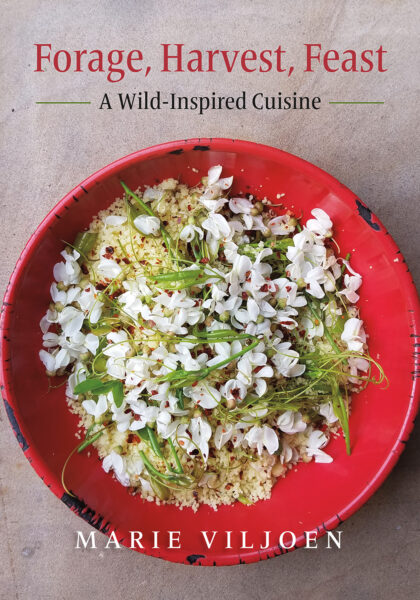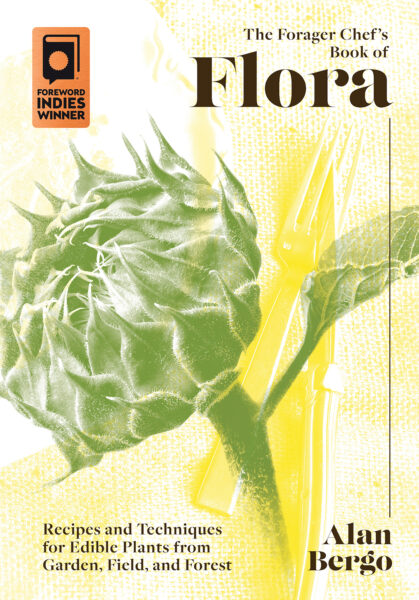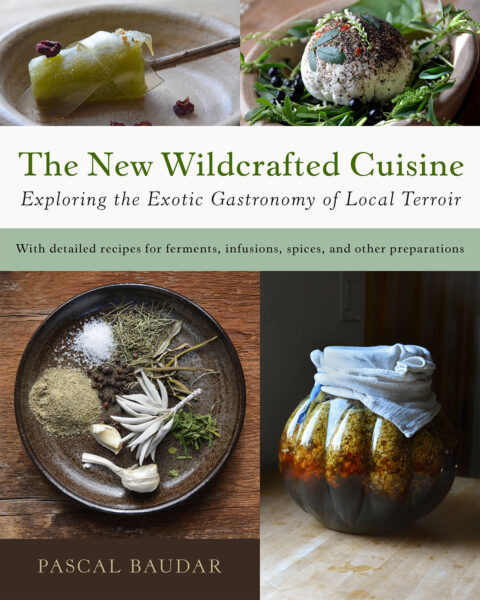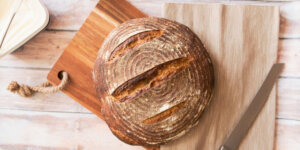Hedges: A Haven for Wild Greens
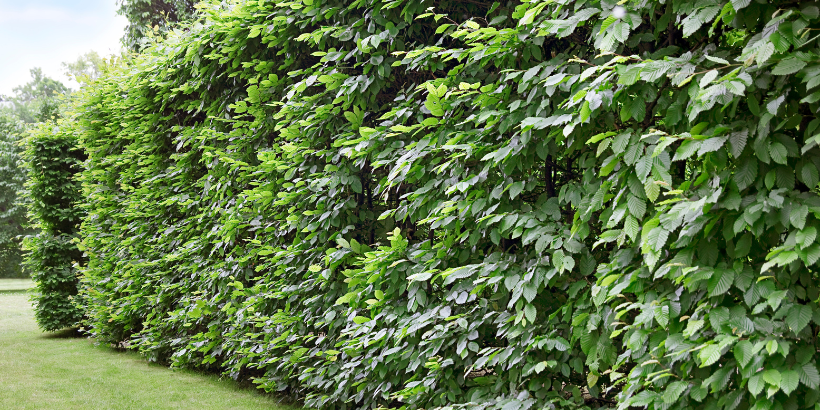
Wondering where to forage for greens this spring? Look no further than hedges, which serve as natural havens for wild greens and herbs!
The following is an excerpt from Hedgelands by Christopher Hart. It has been adapted for the web.
Food from Hedges: Salads and Greens
Let’s start by looking at all the wild foods and remedies available just in the hedge at Underhill.
After blackberries, the green leafy abundance of the hedgerow in March is probably what most people are familiar with. And the choice on offer at this particular salad bar can be dazzling.
The Underhill hedge alone, for instance, offers cleavers, ramsons/wild garlic, cow parsley, dandelion and wood dock.
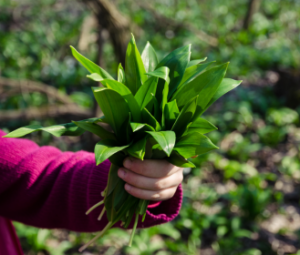 Wild Garlic
Wild Garlic
Wild garlic, like all spring greens, is lovely when quickly fried in butter, but also makes a fantastic soup if you mix it up with equal quantities, more or less, of nettle tops and some good bone stock.
And the absolutely best thing you can do with a leaf or two of wild garlic, and/or dandelion, is to lay them directly inside your Cheddar cheese sandwich when you’re out for a long springtime walk.
Cleavers or goosegrass we have mentioned already: the best and most traditional thing you can do with this abundant plant of many a hedgerow is, as the name suggests, feed it to a goose, and then eat the goose.
But you can also fry the young shoots lightly and eat it direct.
And yes, all species of dock (Rumex) are edible – in moderation.
Eating Wild Foods: Less Is More
As a general rule, all wild foods should only be consumed in moderation. Our ancestors would have foraged from a vast variety of plant foods and, even today, Kalahari bushmen have been found to regularly eat over one hundred different kinds.
So, with dock, for instance, you shouldn’t eat too much because it contains quite high levels of oxalates, which can cause kidney stones.
But so do rhubarb, spinach and almonds, and no one says they’re bad for you. Even broccoli contains bad stuff like thiocyanates. If you were to eat five kilogrammes of broccoli at a sitting, you would probably die. But people tend not to anyway.
In general, a little of everything is best. One of the few food groups that contains no anti-nutrients is meat – because an animal’s favourite ways of not being eaten are to hide, fight back or run away.
Plants can’t hide or run away, so they fight back with anti-nutrients – except fruit, of course, which want to be eaten, so you can spread their seeds around the countryside when you poo.
It’s all very simple really.
Back to your hedgerow salad.
Make A Salad from Hedges
You could also throw in some hawthorn leaves and some petals from the field rose and the dog rose, to be really cheffy, to create a stunning salad from just this one stretch of hedge.
One other plant on Jenny Bennet’s list from the Underhill hedge is soft rush, also said by some to be edible; apparently it is well known in Chinese herbal medicine, while the Japanese make it into a tea, called hui sup. But I haven’t found much solid evidence for its edibility, let alone deliciousness.
Many wild foods fall into the category of ‘may be edible – it’s not exactly clear’, and, if so, I advise caution.
Wild food does tend to taste strong, compared to the bland pap we are used to from the supermarket. Yet it is precisely those strong, slightly bitter flavours that signal its nutritional value. As the year progresses, the leaves’ protective chemicals build up, and I wouldn’t recommend most of them after May.
Nettles: Warnings & Considerations
One fine exception to this, though, is nettles, if they grow on your own patch. Of course, they need cooking first: steamed, plain or sautéed in butter.
But when May or June comes around, if you cut your nettle patch to the ground – and assuming you then get some good summer rain – within just another three weeks or so, you’ll have a whole new crop of bright young nettle shoots to eat a second time around.
I have eaten new-growth nettle tops as late as October, with no negative consequences. But if you try eating stringy older nettles after June, you’ll find that: a) they taste bitter; and b) they are laxative.
You have been warned.
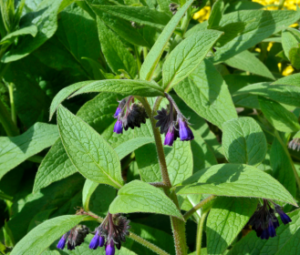 Comfrey Leaves
Comfrey Leaves
Comfrey leaves, by the way, only recently went off the menu, although many older wild-food books recommend them. They’re now known to contain high quantities of rather toxic alkaloids.
Pliny recommended adding them to stewed meat, Culpeper recommends them too and even John Lewis-Stempel eats comfrey fritters, reminding us along the way that comfrey ‘has more protein in its leaf structure than any other British wild plant’.1
If you avoid the comfrey, though, you might still use his ‘leaves in batter’ recipe with something else, coating the leaves in duck-egg yolk, then frittering them with goose fat, chestnut flour and hazelnut oil.
Sounds fantastic. What about with wild garlic and some very young horseradish leaves?
Hawthorn leaves are about the best tree-leaves to eat in spring (though you can also try beech and lime).
They used to be called bread-and-cheese by country children, in honour of which Streeter and Richardson suggest laying a bunch of fresh young hawthorn leaves on pieces of fried bread, topping with cheese and grilling until bubbling.2 Delicious.
Healing Powers of Yarrow
There’s a strong and unsubtle clue about the healthy powers of yarrow merely in the name: it’s related to the Old English for ‘healer’, gearwe, while other folk names include woundwort and staunchwort. The Romans called it herba militaris, ‘soldier’s herb’, for its healing powers.
It used to be used instead of hops to preserve and flavour ale, and I’ve done a 24-hour cold-tea brew of yarrow flowers and meadowsweet flowers, which was excellent.
You can also do the Anglo-Saxon thing with your ale, adding either herb, or any other suitable one – flowers or leaves – to your glass before you pour on your wine or your ale. Use spicy herbs for wine, pungent ones for ale, and leave them for a few minutes to infuse.
The results are enjoyably unpredictable.
Foraging: From then to Now
The truth is we are terribly dull nowadays with our foraging and cooking compared to our forebears.
Consider a surviving recipe for an English omelette with herbs, from the early Middle Ages: it contained 16 eggs, chopped dittany, rue, tansy, mint, sage, marjoram, fennel, parsley, beets, violet leaves, spinach, lettuce and pounded ginger.
Who would mix ginger with eggs and mint nowadays? But it might be delicious. Violet leaves are edible; tansy and rue are often overlooked old
English pot herbs, along with that old staple of the herb garden, lovage; and the dittany is now almost completely forgotten.
Dittander
I actually take this to be what is more commonly called dittander, also erroneously dittany (Lepidium latifolium), another member of the cabbage/brassica family, so many of them with powerful health-giving properties and not the dittany Dictamnus albus, which doesn’t appear to be edible.
Dittander is a perennial of damp ground near the coast, used as a spicy condiment before the horseradish was introduced from the Near East, and recommended by medievalists for leprosy, hence surely its continuing presence in the grounds of the Hospital of St James and St Mary Magdalen in Chichester, founded in the twelfth century.3
What about carbohydrates, often a sought-after rarity for the novice wild forager? Roots and tubers are one of the best and healthiest sources of carbs – healthier than grass grains like wheat and barley. Have you ever heard of anyone with a potato or sweet potato intolerance? It’s very rare.
The First Foraged Foods
But what did the wild-food forager eat before the cultivation of the humble spud or the earliest spelt and emmer grains?
John Lewis-Stempel maintains that the tubers of silverweed were the ones we ate in Britain before the arrival of the potato, which is persuasive, but I imagine that we ate dozens of different bulbs, roots and tubers in the very old days: silverweed, burdock, horseradish, wild garlic, bullrush, and no doubt many more that we’ve forgotten.
Silverweed and bullrush, along with flowering rush, reedmace and other plants of the ditch and wetland, have roots that can be baked and then ground into flour.
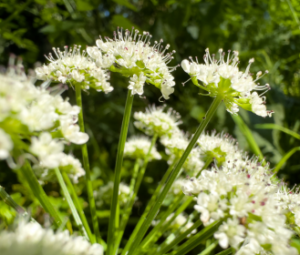 Pignut: A Staple of Hedges
Pignut: A Staple of Hedges
But another absolute staple – and the one that appears at Underhill – is the pignut.
You have to get really palaeolithic here with a pointy digging stick but, if you enjoy such things, it’s fun.
You dig straight down beside the pignut and then along a bit to find the walnut-sized tuber, which is always at a right angle to it.
‘A sweet chestnut crossed with a radish’ is one very good description I’ve heard. It’s excellent eating, especially roasted, like all roots.
I should add that Culpeper warns us that pignut can be a little too good for you, though, and ‘provoke lust exceedingly and stir up those sports she is mistress of ’. Treat with caution.
Hedge Garlic
Another root that you can find everywhere and eat with a clear conscience, as it’s so common, is hedge garlic, or jack-by- the-hedge. It’s a little like horseradish.
Grate it raw over pretty much anything for added zing: roast potatoes or steamed greens, fresh salads, add a little oil; it’s a terrific flavouring. And being a brassica of the cabbage family, it has enormous health benefits.
Cultivate eagerly all along your hedge.
Wild Garlic
My absolute favourite wild green has to be wild garlic, though. If you mix it 50/50 with young nettle tops, it’s a fantastic side vegetable, but it also makes a terrific pesto.
The original Italian version uses pine nuts and parmesan, of course, but you can make a delicious UK-based equivalent (in fact, it’s probably cultural appropriation) if you mix a handful of raw wild garlic leaves, some roasted hazelnuts, any strong hard cheese and a good gloop of olive oil.
Blitz it in a food processor and devour.
Notes
1. John Lewis-Stempel, The Wild Life (London: Doubleday, 2009), 197.
2. David Streeter and Rosamond Richardson, Discovering. Hedgerows (London: BBC Books, 1982), 51.
3. Richard Mabey, Flora Britannica (London: Chatto and Windus, 1996), 152–53.
Recommended Reads
Recent Articles
Introducing…your new favorite brunch dish! This whole broccoli frittata is packed with fresh, wildcrafted flavors that are bound to help you start your day off on the right foot. The following is an excerpt from The Forager Chef’s Book of Flora by Alan Bergo. It has been adapted for the web. RECIPE: Whole Broccoli Frittata…
Read MoreWondering where to forage for greens this spring? Look no further than hedges, which serve as natural havens for wild greens and herbs! The following is an excerpt from Hedgelands by Christopher Hart. It has been adapted for the web. Food from Hedges: Salads and Greens Let’s start by looking at all the wild foods…
Read MoreThere’s a whole new world out there when it comes to koji. It doesn’t matter if you’re making bread, cheese, or ice cream, koji helps you pump up the flavor! Growing Koji in Your Own Kitchen Koji, the microbe behind the delicious, umami flavors of soy sauce, miso, fermented bean sauce, and so many of…
Read MoreWhether you’re looking to replace your end-of-the-day cocktail, relax before bed, or want something new to add to your tea, this non-alcoholic mocktail syrup base will do the trick. Delicious and all-natural, take a sip of this nightcap mocktail and feel your troubles melt away. The following is an excerpt from Herbal Formularies for Health…
Read MoreWant to enjoy bread without worrying about gluten? With Einkorn bread, a light bread with the lowest glycemic index, you can still enjoy all of the delights of bread. without any of the allergic reactions! The following is an excerpt from Restoring Heritage Grains by Eli Rogosa. It has been adapted for the web. Einkorn…
Read More

![The Hedgelands [US Edition] cover](https://www.chelseagreen.com/wp-content/uploads/9781915294470-300x449.jpg)
